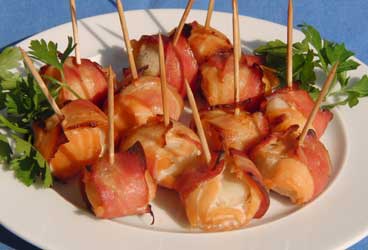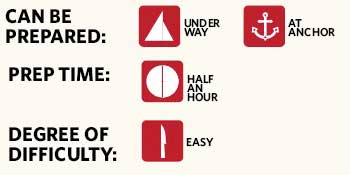
One thing about cruising hasn’t changed since my book, Cooking on the Go, came out in 1987: Stuff happens. The refrigeration could fail. You could arrive in port, desperate for ice, only to find there’s none available.
When the cold quits, provisions are lost. It’s a budget disaster at any time, and on a long passage, it can mean short rations. As a cruising cook who wants backups for my backups, I keep on board plenty of shelf-stable provisions, food items that have been processed so they can be safely stored in a sealed container at room or ambient temperature for a usefully long shelf life.
While canned combinations are convenient, flavors can blend too well. For fresher taste, buy single ingredients and combine them artfully. Go for variety in taste, color, and texture. Here’s what works for me.
Tinned water chestnuts keep their crunch. Rinse and drain, then add them to stir-fries and salads. To use in salads, marinate them for several hours in vinaigrette. Or use them to make a gourmet appetizer such as “Scrumptious Salmon Bites.” (See the recipe at right.) Canned beets are another food you can use in many ways. Serve them hot or cold, Harvard-style or pickled. Small, whole beets add a nice touch of color to kebabs. Shredded beets make borscht. Also, canned cut green beans make a salad when served cold with vinaigrette and dried dill.
Fresh fish is the favored meal for most cruisers, but I also keep on hand a variety of canned seafood, including shrimp, clams, mussels, lobster, oysters, salmon, and tuna. When the line comes up empty or the catch is too small, canned items combine to make tasty bouillabaisse, fish cakes, or chowder.
Without cream, New England-style chowder just isn’t the same. But even such substitutes as evaporated milk or U.H.T. cream have a shelf life. If you’re pressed, use powdered milk at double strength; let it stand for two to three hours to allow it to combine fully and lose that chalky taste.
We all know about protecting provisions from rats, rust, and moisture, but here’s a special warning about aluminum cans and pouches: Salt water eats through them, so seal them in plastic bags. The rings on pull-top cans are also vulnerable; a slight tap can create a pinhole opening. Bag such cans or add a strip of tape to protect the rings.
Protecting freshness also means rotating supplies according to use-by dates, which vary widely. Outdated foods may be safe to eat, but they gradually lose nutrients, texture, and color. Damp sea air is deadly on dried foods and spices. I buy spices in small sizes and long-life dehydrates in smaller cans, then use them as quickly as possible.
Not all canned or dried foods are created equal. Try products before you buy in case lots. Don’t be far from home when you discover you hate that bargain-brand beef stew! And when for whatever reason you find yourself low on fresh provisions, pull out those tested backup stores and get creative! Here’s one of my favorite combinations for an easy cocktail-hour hors d’oeuvre.
Scrumptious Salmon Bites
- 12 canned whole water chestnuts, drained
- 8 ounces smoked salmon
- 12 thin slices bacon, cut in half
Cut salmon into thin strips. Wrap each water chestnut in one strip of salmon and one-half strip of bacon. Secure with toothpicks. Bake at 375 degrees F until bacon is browned and crisp, about 20 to 25 minutes. Garnish with whatever you have on hand! Makes 12.
For canned bacon, go to MREdepot . For packaged smoked salmon requiring no refrigeration, go to SeaBear.









